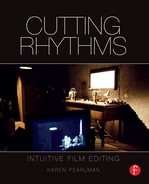This book is based on the doctoral thesis Cutting Rhythms: Ideas about the Shaping of Rhythm in Film Editing, by Dr. Karen Pearlman, University of Technology, Sydney, 2006.
An earlier version of Chapter 1 of this book was published as “The Rhythm of Thinking—speculations on how an editor shapes the rhythm of a film,” in a special feature section on editing in Metro Magazine, a publication of the Australian Teachers of Media, 141, pp. 112–116, 2004.
Excerpts from Chapters 4, 5, and 6 were published in a series of three articles in the journal of the Dance Films Association, New York, 2005–2006 (Dance on Camera Journal, July–August 2005, 8(4); Dance on Camera Journal, September–October 2005, 8(5); and Dance on Camera Ezine, February 9, 2006).
An earlier version of Chapter 11 was published in Lumina, The Australian Journal of Screen Arts and Business, Issue 11, 2013.
The ideas in Chapter 12, Editing Thinking and Onscreen Drafting, are part of an ongoing research project being supported by a Macquarie University New Staff Grant, and there will be additional scholarly publications forthcoming on these topics.
The second edition of this book owes a debt to my colleagues at Macquarie University: Kathryn Millard, Iqbal Barkat, Tom Murray, Maree Delofski, Gill Ellis, Joseph Pugliese, Catharine Lumby, and Nicole Anderson who have all contributed to supporting my research and writing. Thank you to all of the Dept. of Music, Media, Communications and Cultural Studies for welcoming me into your community and creating such a collegial and stimulating environment.
I’d like to acknowledge the skill, commitment, and excellent advice of my doctoral supervisor, Sarah Gibson, and my co-supervisor, Professor Ross Gibson, whose own writings have been so significant in shaping my ideas. I’d like also to acknowledge the influence and inspiration provided by my original supervisor, Dr. Patrick Crogan. Acknowledgment and thanks are due to Bill Russo, ASE, former Head of Editing at the Australian Film Television and Radio School (AFTRS), for his curiosity, challenges, and discussions. I would also like to acknowledge Paul Thompson, professor at the NYU Tisch Film School, for his articulation of ideas about “hope and fear.” A thank you to Philippa Harvey, Mark Warner, Matthew Campora, and all of my colleagues at the AFTRS for their insights and interest, as well as my former and current students at Macquarie University, the AFTRS, and at the University of Technology, Sydney (UTS), whose energy and passion for their work have been so inspiring.
While doing my doctorate, the lecturers at UTS in the Department of Media Arts and Production, were all influential and often, perhaps without knowing it, dropped in a remark or an idea that set me thinking. Special thanks to the then Dean of the Faculty of Arts and Sciences at UTS, Professor Theo van Leeuwen, for his work on rhythm in film and for bringing key texts to my attention.
My highly esteemed colleagues at the Australian Screen Editors Guild have been a great inspiration for me, and I’d particularly like to acknowledge the input, advice, and encouragement of Henry Dangar, ASE; Emma Hay, ASE; Peter Whitmore, ASE; Jane St. Vincent Welch, ASE; Dany Cooper, ASE; and Jason Ballantine, ASE. I also acknowledge the advice and assistance of Dr. Stephen Malloch, Dr. Greg Hooper, and Dr. Mark Seton in discussion of particular problems and in locating particular texts. Dr. Christopher Allen, Michelle Hiscock, Dierdre Towers, Darmyn Calderon, J. Gluckstern, and Ross Murray have all been kind enough to read some parts of the manuscript, and I thank them for their comments and suggestions.
At Focal Press, I am also indebted to the editor of the first edition Elinor Actipis, the editor who commissioned the second edition Dennis McGonagle, and editors of the second edition: Elliana Arons, Emily McCloskey, and Peter Linsley. Thank you to the Focal Press readers Cari Ann Shim Sham and Jerry Hofman for your insights and suggestions.
Finally, for having gotten this far I owe a debt to my family: my father, Dr. Alan Pearlman, whom I “mirror” in all of my thinking, and his wife, Gail Bass, whose knowledge of music has provided stimulating debates about rhythm; my mother, Joan Pearlman, an endless source of enthusiasm and loving support, and her husband, Professor Peter Kivy, who gave me my first books on film theory. To the memory of my father-in-law, Robert Allen, and special thanks to my mother-in-law, Jocelyn Allen, who lifted the burdens of all my daily cares and held them aloft so graciously while I sheltered with her and wrote. Then there are the gorgeous ones, my children Sam and Jaz, my raisons d’être, who inspire me to get up in the morning and in absolutely everything else, and my wonderful partner, Richard, the astounding river of energy, vision, and love running through it all. With love and thanks to you all, here it is!
